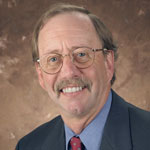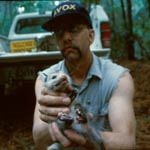
San Antonio (Dec. 14, 2004) – When Steven N. Austad, Ph.D., wants to study aging in animals, he goes to interesting places to do it. What he reports is of keen interest in aging research circles.
A professor of cellular and structural biology at The University of Texas Health Science Center at San Antonio since summer 2004, Dr. Austad is a comparative biologist. He doesn’t study aging in one animal but in many – and not in those usually studied by most scientists. He is a member of the Sam and Ann Barshop Institute for Longevity and Aging Studies, which is part of the Health Science Center.
“My niche is to think about learning about aging by looking at animals that are nontraditional, that nobody else thinks about,” Dr. Austad said. “Instead of studying lab mice, I study mice from nature. I look at bats and birds and other things chosen not because there is a lot of biological science background about them but because they can teach us about aging.”
He mentions a bat the size of a mouse that can live 30 years in the wild. Bats generally are very long lived, in contrast to a mouse that lives at best two to three years under the best lab circumstances.
“The Methuselahs are bats, generally speaking, and birds,” Dr. Austad said, referring to the man in Genesis who lived a record 969 years. “People don’t tend to realize how long birds live. A mouse-sized bird can live 20 years. Birds are interesting because their biology, high body temperature and metabolic rate would cause you to think they are short lived. But they are long lived, so it begs the question: What’s going on in their cells to enable them to do this?”
Experienced researcher
Dr. Austad, who has served on the faculties of Purdue, New Mexico, Harvard, Washington and most recently the University of Idaho, brought to the Health Science Center a $1.5 million National Institutes of Health grant titled “Comparative Mechanisms of Exceptionally Slow Aging” and an $835,000 Senior Scholar Award from the Ellison Medical Foundation.
He received his Ph.D. at Purdue in 1981 and started as a field biologist. On islands off the coast of Georgia, he studied a group of opossums that age more slowly than their counterparts on the mainland.
“I’ve also spent time on at least four islands in the tropical Pacific bringing back populations of mice,” he said. “The reason we think animals from these islands might be particularly interesting is that the islands have few predators and milder climates and, as a consequence, the animals basically live in very safe environments.
“Existing theories about aging suggest that animals that live in these safe environments, where they are less likely to be killed by accident, have the natural tools to live longer, such as stronger immune systems and hearts.”

Dr. Austad found wild mice on Majuro in the Marshall Islands and on Pohnpei, Kosrae and Chuuk in the Federated States of Micronesia. “These are different populations of the house mouse, which is used in medical labs throughout the world,” he said. “The wild mice are one-quarter to one-third the size of regular lab mice, and they generally are longer lived.”
He hasn’t studied Texas mice so far, but has wild mice from his days in Idaho.
“I was not at all looking to leave Idaho, but the aging program at the Health Science Center is quite probably the finest in the world,” Dr. Austad said. “It was difficult to pass up the chance to work with so many talented colleagues here who are interested in the same thing.”
Dr. Austad, who also has an appointment with the South Texas Veterans Health Care System, received a bachelor of arts in English literature from The University of California at Los Angeles in 1969.
Early career
Proving that truth is stranger than the literature he studied, Dr. Austad went on to tame lions in the movie business. He even met young actress Melanie Griffith while working for her parents. “I actually pulled her head out of a lion’s mouth one time when she was knocked down on the set and might have been seriously injured,” he said. “Her mother, actress Tippi Hedren, still has an orphanage for big cats.”
His scientific training brought other experiences. A world away from Hollywood, Dr. Austad did field work on cuscuses (arboreal marsupials) in Papua New Guinea. In Venezuela, he studied opossums and wrens.
He has written popular scientific books for general audiences. In 1997, John Wiley & Sons published his book “Why We Age: What Science Is Discovering about the Body’s Journey Through Life.” The paperback edition was published in 1999 with translations available in Chinese, Japanese, Korean, Italian, Spanish, Finnish and Czech.
One of the grandest moments of his career occurred in 2003, when he received the Robert W. Kleemeier Award for Outstanding Research from the Gerontological Society of America. Incidentally, the 2004 winner of the gerontology profession’s highest honor is James R. Smith, Ph.D., also of the Health Science Center.
Dr. Austad’s current professional service includes membership on the Science Advisory Board of National Public Radio and on a National Institutes of Health study section reviewing research proposals pertaining to cellular mechanisms of aging and development.
His wife, Dr. Veronika Kiklevich, is a veterinarian and plans to open a specialty practice in animal dentistry. Together they have written a book of humorous animal stories titled “Real People Don’t Own Monkeys.” Dr. Austad also is working on a book about the criminal justice system.

